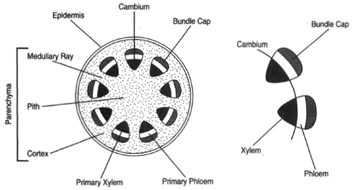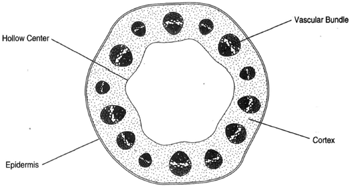The Herbaceous Dicot Stem
The distinction between woody stems and herbaceous stems is not always absolute. In general, however, herbaceous stems do not produce enough secondary growth to make recognizable wood, and they die back to the ground at the end of the growing season.An herbaceous dicot stem is very similar to the apical end of a woody dicot stem, where no secondary growth has taken place (figure 32-2b); the arrangement of tissues is the same. Figure 32-11 shows a cross section of an herbaceous dicot stem. Vascular bundles are arranged in a circle. This arrangement helps distinguish a central pith and an outer cortex, both of which are parenchyma. The cortex and pith are contiguous by the parenchyma that lies between vascular bundles. These areas are called medullary rays. The outermost layer is the epidermis. The vascular bundles have bundle caps lying outside the phloem. The cells of the cap are thick-walled sclerenchyma. Some of the vascular bundles pass out from the vascular cylinder to the leaves. These are leaf traces, and they may occur in threes, fives, occasionally more, and sometimes only one.
Herbaceous dicot stems are sometimes hollow. In some species, the hollow space is lined with an endodermis; in others, there is no endodermis, and the space is instead lined with parenchyma.
 |
| Figure 32-11 A cross section of an herbaceous dicot stem and at ther ight two vascular bundles showing cambium running through and continuous between the bundles. |
 |
| Figure 32-12 Cross section of an herbaceous dicot stem having a hollow center. |




